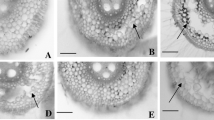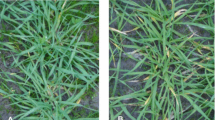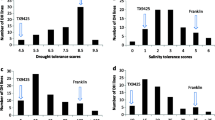Abstract
Key message
Aerenchyma formation after 7 days of waterlogging in commercial potting mixture can be a reliable, fast, and widely utilized approach for the selection of waterlogging tolerant barley genotypes. One major QTL for aerenchyma formation after 7 days of waterlogging treatment was identified and the newly developed markers explained 44 % of the phenotypic variance. This QTL can now be effectively used in barley breeding programs.
Abstract
Waterlogging is one of the important limiting conditions for crop yield and productivity. The main feature of waterlogged soils is oxygen deprivation, due to slow gas diffusion in water. Decreased oxygen content in waterlogged soils leads to the oxygen deficiency in plant tissues, resulting in reduced energy availability for plants. Rapidly induced aerenchyma formation is critical to maintaining adequate oxygen supply and overall waterlogging tolerance in barley. In this study, we have proved that quantifying aerenchyma formation after 7 days of waterlogging in commercial potting mixture can be a reliable, fast, and widely utilised approach for the selection of waterlogging tolerant barley genotypes, which is supported by measurements of redox potential (an indicator of anaerobic conditions). This protocol was also used to identify quantitative trait loci (QTL) in a doubled haploid population of barley from the cross between Yerong (tolerant) and Franklin (sensitive) genotypes. The QTL for aerenchyma formation and root porosity were at the same location as the waterlogging tolerance QTL. Seven new markers were developed and added onto this region on chromosome 4H. One major QTL for aerenchyma formation after 7 days waterlogging treatment explained 44.0 % of the phenotypic variance. This successful QTL for aerenchyma formation can be effectively used in the marker assisted selection to improve waterlogging tolerance in barley.







Similar content being viewed by others
References
Armstrong W (1979) Aeration in higher plants, vol 7. Advances in Botanical Research. London
Bailey-Serres J, Colmer TD (2014) Plant tolerance of flooding stress—recent advances. Plant Cell Environ 37(10):2211–2215. doi:10.1111/pce.12420
Broughton S, Zhou G, Teakle N, Matsuda R, Zhou M, O’Leary R, Colmer T, Li C (2015) Waterlogging tolerance is associated with root porosity in barley barley (Hordeum vulgare L.). Mol Breed 35(1):1–15. doi:10.1007/s11032-015-0243-3
Collard BCY, Jahufer MZZ, Brouwer JB, Pang ECK (2005) An introduction to markers, quantitative trait loci (QTL) mapping and marker-assisted selection for crop improvement: the basic concepts. Euphytica 142(1–2):169–196. doi:10.1007/s10681-005-1681-5
Colmer TD (2003) Long-distance transport of gases in plants: a perspective on internal aeration and radial oxygen loss from roots. Plant Cell Environ 26:17–36
Colmer TD, Voesenek LACJ (2009) Flooding tolerance: suites of plant traits in variable environments. Funct Plant Biol 36:665–681
de Dorlodot S, Forster B, Pagès L, Price A, Tuberosa R, Draye X (2007) Root system architecture: opportunities and constraints for genetic improvement of crops. Trends Plant Sci 12(10):474–481. doi:10.1016/j.tplants.2007.08.012
Evans DE (2004) Aerenchyma formation. New Phytol 161:35–49
Fiedler S, Vepraskas MJ, Richardson JL, Donald LS (2007) Soil redox potential: Importance, field measurements, and observations. In: Advances in Agronomy, vol Volume 94. Academic Press, p 1–54. doi:10.1016/S0065-2113(06)94001-2
Garthwaite AJ, von Bothmer R, Colmer TD (2003) Diversity in root aeration traits associated with waterlogging tolerance in the genus Hordeum. Funct Plant Biol 30:875–889
Huang X, Shabala S, Shabala L, Rengel Z, Wu X, Zhang G, Zhou M (2014) Linking waterlogging tolerance with Mn2+ toxicity: a case study for barley. Plant Biol 17:26–33. doi:10.1111/plb.12188
Li H, Vaillancourt R, Mendham N, Zhou M (2008) Comparative mapping of quantitative trait loci associated with waterlogging tolerance in barley (Hordeum vulgare L.). BMC Genom 9:401. doi:10.1186/1471-2164-9-401
Malik AI, Islam AKMR, Colmer TD (2011) Transfer of the barrier to radial oxygen loss in roots of Hordeum marinum to wheat (Triticum aestivum): evaluation of four H. marinum–wheat amphiploids. New Phytol 190(2):499–508. doi:10.1111/j.1469-8137.2010.03519.x
Mano Y, Omori F (2008) Verification of QTL controlling root aerenchyma formation in a maize × teosinte “Zea nicaraguensis” advanced backcross population. Breed Sci 58:217–223
Mano Y, Omori F (2009) High-density linkage map around the root aerenchyma locus Qaer1.06 in the backcross populations of maize Mi29 × teosinte “Zea nicaraguensis”. Breeding Science 59(4):427–433
Mano Y, Takeda K (2012) Accurate evaluation and verification of varietal ranking for flooding tolerance at the seedling stage in barley (Hordeum vulgare L.). Breed Sci 62(1):3–10. doi:10.1270/jsbbs.62.3
Mano Y, Omori F, Takamizo T, Kindiger B, Bird RM, Loaisiga CH (2006) Variation for root aerenchyma formation in flooded and non-flooded maize and teosinte seedlings. Plant Soil 281(1–2):269–279. doi:10.1007/s11104-005-4268-y
Mano Y, Omori F, Takamizo T, Kindiger B, Bird RM, Loaisiga CH, Takahashi H (2007) QTL mapping of root aerenchyma formation in seedlings of a maize × rare teosinte “Zea nicaraguensis” cross. Plant Soil 295(1–2):103–113. doi:10.1007/s11104-007-9266-9
Mano Y, Omori F, Kindiger B, Takahashi H (2008) A linkage map of maize maize × teosinte Zea luxurians and identification of QTLs controlling root aerenchyma formation. Mol Breed 21(3):327–337. doi:10.1007/s11032-007-9132-8
Muhlenbock P, Plaszczyca M, Plaszczyca M, Mellerowicz E, Karpinski S (2007) Lysigenous aerenchyma formation in Arabidopsis is controlled by lesion simulating disease1. Plant Cell 19:3819–3830
P de San Celedonio R, Abeledo LG, Miralles D (2014) Identifying the critical period for waterlogging on yield and its components in wheat and barley. Plant Soil 378(1–2):265–277. doi:10.1007/s11104-014-2028-6
Pang J, Zhou M, Mendham N, Shabala S (2004) Growth and physiological responses of six barley genotypes to waterlogging and subsequent recovery. Aust J Agric Res 55(8):895–906. doi:10.1071/ar03097
Raskin I (1983) A method for measuring leaf volume, density, thickness, and internal gas volume. HortScience 18:698–699
Reddy KR, Patrick WH Jr (1976) Effect of frequent changes in aerobic and anaerobic conditions on redox potential and nitrogen loss in a flooded soil. Soil Biol Biochem 8(6):491–495. doi:10.1016/0038-0717(76)90091-2
Semagn K, Beyene Y, Warburton M, Tarekegne A, Mugo S, Meisel B, Sehabiague P, Prasanna B (2013) Meta-analyses of QTL for grain yield and anthesis silking interval in 18 maize populations evaluated under water-stressed and well-watered environments. BMC Genom 14(1):313
Septiningsih EM, Pamplona AM, Sanchez DL, Neeraja CN, Vergara GV, Heuer S, Ismail AM, Mackill DJ (2009) Development of submergence-tolerant rice cultivars: the Sub1 locus and beyond. Ann Bot 103:151–160
Setter TL, Burgess P, Waters I, Kuo J (1999) Genetic diversity of barley and wheat for waterlogging tolerance in Western Australia. Paper presented at the Australian Barley Technical Symposium
Shabala S (2011) Physiological and cellular aspects of phytotoxicity tolerance in plants: the role of membrane transporters and implications for crop breeding for waterlogging tolerance. New Phytol 190(2):289–298. doi:10.1111/j.1469-8137.2010.03575.x
Shabala S, Shabala L, Barcelo J, Poschenrieder C (2014) Membrane transporters mediating root signalling and adaptive responses to oxygen deprivation and soil flooding. Plant Cell Environ 37(10):2216–2233. doi:10.1111/pce.12339
Thomson CJ, Armstrong W, Waters I, Greenway H (1990) Aerenchyma formation and associated oxygen movement in seminal and nodal roots of wheat. Plant Cell Environ 13:395–403
Unger IM, Motavalli PP, Muzika R-M (2009) Changes in soil chemical properties with flooding: a field laboratory approach. Agric Ecosyst Environ 131:105–110. doi:10.1016/j.agee.2008.09.013
Van Ooijen JW, Kyazma BV (2009) MapQTL 6. Software for the mapping of quantitative trait loci in experimental populations of diploid species Kyazma BV. Wageningen, Netherlands
Voorrips RE (2002) MapChart: software for the graphical presentation of linkage maps and QTLs. J Hered 93(1):77–78. doi:10.1093/jhered/93.1.77
Xu Y, Crouch JH (2008) Marker-assisted selection in plant breeding: from publications to practice. Crop Sci 48(2):391–407. doi:10.2135/cropsci2007.04.0191
Zhang X, Shabala S, Koutoulis A, Shabala L, Johnson P, Hayes D, Nichols D, Zhou M (2015) Waterlogging tolerance in barley is associated with faster aerenchyma formation in adventitious roots. Plant Soil 394(1–2):355–372. doi:10.1007/s11104-015-2536-z
Zhou M (2010) Improvement of plant waterlogging tolerance. In: Mancuso S, Shabala S (eds) Waterlogging signalling and tolerance in plants. Springer-Verlag, Heidelberg, Germany, p 267–285. doi:10.1007/978-3-642-10305-6_13, #Springer-Verlag
Zhou M (2011) Accurate phenotyping reveals better QTL for waterlogging tolerance in barley. Plant Breed 130(2):203–208. doi:10.1111/j.1439-0523.2010.01792.x
Zhou MX, Li HB, Mendham NJ (2007) Combining ability of waterlogging tolerance in barley. Crop Sci 47(1):278–284. doi:10.2135/cropsci2006.02.0065
Zhou M, Johnson P, Zhou G, Li C, Lance R (2012) Quantitative trait loci for waterlogging tolerance in a barley cross of Franklin × YuYaoXiangTian Erleng and the relationship between waterlogging and salinity tolerance. Crop Sci 52(5):2082–2088. doi:10.2135/cropsci2012.01.0008
Zhou G, Zhang Q, Tan C, XQ Zhang, Li C (2015) Development of genome-wide InDel markers and their integration with SSR, DArT and SNP markers in single barley map. BMC Genom 16(1):1–8. doi:10.1186/s12864-015-2027-x
ZoBell CE (1946) Studies on redox potential of marine sediments. AAPG Bull 30(4):477–513
Acknowledgments
This work was supported by the Australian Research Council Linkage grant (LP120200516) and Grains Research & Development Corporation (GRDC) of Australia.
Author information
Authors and Affiliations
Corresponding author
Ethics declarations
Conflict of interest
The authors have declared that no conflict of interest exists.
Additional information
Communicated by L. Jiang.
Rights and permissions
About this article
Cite this article
Zhang, X., Zhou, G., Shabala, S. et al. Identification of aerenchyma formation-related QTL in barley that can be effective in breeding for waterlogging tolerance. Theor Appl Genet 129, 1167–1177 (2016). https://doi.org/10.1007/s00122-016-2693-3
Received:
Accepted:
Published:
Issue Date:
DOI: https://doi.org/10.1007/s00122-016-2693-3




